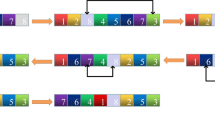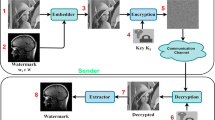Abstract
Medical information management has progressed in the last few years because of the advances in information technologies. Nowadays, it is possible to share medical images among specialists geographically distant to interpret, discuss, and get improved diagnostics. However, any alteration of transmitted image metadata may lead to issues related to information security, such as detachment and authentication. Detachment refers to link the data of an electronic patient record to an incorrect medical image, while authentication aims to identify the image source. These security problems are critical as they may cause the loss of sensitive data or wrong medical diagnoses. Digital watermarking is an emerging technique that faces these security problems as it allows to embed the metadata directly into the medical image. This paper proposes a hybrid and robust watermarking technique to prevent detachment and authenticate medical images. The quantization index modulation algorithm under dither modulation in conjunction with forwarding error correction is used to embed relevant metadata as a robust-imperceptible watermarking to avoid detachment. The visible-imperceptible watermarking paradigm, whose use is an innovation in medical images, is applied to insert a second watermark in the spatial domain to perform authentication. The experimental results show the contribution of the proposed scheme and its efficiency regarding robustness and imperceptibility.










Similar content being viewed by others
References
National Electrical Manufacturers Association (NEMA), DICOM Security. 8 Feb 2020. https://www.dicomstandard.org/using/security/
Coatrieux, G., Quantin, C., et al.: Watermarking medical images with anonymous patient identification to verify authenticity. In: Studies in Health Technology and Informatics, Vol. 136, pp. 667–672. IOS Press (2008)
Qasim, A.F., Meziane, F., Aspin, R.: Digital watermarking: applicability for developing trust in medical imaging workflows state of the art review. Comput. Sci. Rev. 27, 45–60 (2018). https://doi.org/10.1016/j.cosrev.2017.11.003
Mousavi, S.M., Naghsh, A., Abu-Bakar, S.A.R.: Watermarking techniques used in medical images: a survey. J. Digit Imaging 27, 714–729 (2014). https://doi.org/10.1007/s10278-014-9700-5
Das, S., Kundu, M.K.: Effective management of medical information through a novel blind watermarking technique. J. Med Syst. 36, 3339–3351 (2012). https://doi.org/10.1007/s10916-012-9827-1
Cedillo-Hernandez, M., et al.: Robust watermarking method in DFT domain for effective management of medical imaging. SiVP Springer 9, 1163–1178 (2015). https://doi.org/10.1007/s11760-013-0555-x
Kalaivani, K.: An efficient watermarking scheme for medical data security with the aid of neural network. Braz. Archiv. Biol. Technol. 59(spe2), e16161070, 1–12 (2016). https://doi.org/10.1590/1678-4324-2016161070
Aherrahrou, N., Tairi, H.: PDE based scheme for multi-modal medical image watermarking. BioMed Eng. OnLine 14(108), 1–19 (2015). https://doi.org/10.1186/s12938-015-0101-x
Cedillo-Hernandez, M., et al.: Security enhancement of medical imaging via imperceptible and robust watermarking. IEICE Trans. Inf. Syst E98-D5(9), 1702–1705 (2015). https://doi.org/10.1587/transinf.2015EDL8016
Singh, A.K., Dave, M., Mohan, A.: Hybrid technique for robust and imperceptible multiple watermarking using medical images. Multimed. Tools Appl. 75, 8381–8401 (2016). https://doi.org/10.1007/s11042-015-2754-7
Mousavi, S.M., et al.: A robust medical image watermarking against salt and pepper noise for brain MRI images. Multimed. Tools Appl. 76, 10313–10342 (2017). https://doi.org/10.1007/s11042-016-3622-9
Rodriguez-Colin, R., et al.: A robust watermarking scheme applied to radiological medical images. IEICE Trans. Inf. Syst. E91-D(3), 862–864 (2008). https://doi.org/10.1093/ietisy/e91-d.3.862
Sharma, A., Singh, A.K., Ghrera, S.P.: Secure hybrid robust watermarking technique for medical images. Procedia Comput. Sci. 70, 778–784 (2015). https://doi.org/10.1016/j.procs.2015.10.117
Thakkar, F.N., Srivastava, V.K.: A blind medical image watermarking: DWT-SVD based robust and secure approach for telemedicine applications. Multimed. Tools Appl. 76, 3669–3697 (2017). https://doi.org/10.1007/s11042-016-3928-7
Gangadhar, Y., et al.: An evolutionary programming approach for securing medical images using watermarking scheme in invariant discrete wavelet transformation. Biomed. Signal Process. Control 43, 31–40 (2018). https://doi.org/10.1016/j.bspc.2018.02.007
Swaraja, K.: Medical image region-based watermarking for secured telemedicine. Multimed. Tools Appl. 77(21), 28249–28280 (2018). https://doi.org/10.1007/s11042-018-6020-7
Sharma, A., Singh, A.K., Ghrera, S.P.: Robust and secure multiple watermarking for medical images. Wirel. Pers Commun. 92, 1611–1624 (2017). https://doi.org/10.1007/s11277-016-3625-x
Mahesh Selvi, T., Kavitha, V.: A privacy-aware deep learning framework for health recommendation system on analysis of big data. Vis. Comput. (2021). https://doi.org/10.1007/s00371-020-02021-1
Cedillo-Hernandez, M., Cedillo-Hernandez, A., Nakano-Miyatake, M., Perez-Meana, H.: Improving the management of medical imaging by using robust and secure dual watermarking. Biomed. Signal Process. Control 56, 101695 (2020). https://doi.org/10.1016/j.bspc.2019.101695
Nuñez-Ramirez, D., Cedillo-Hernandez, M., Nakano-Miyatake, M., Perez-Meana, H.: Efficient management of ultrasound images using digital watermarking. IEEE Lat. Am. Trans. 18(08), 1398–1406 (2020). https://doi.org/10.1109/TLA.2020.9111675
Kahlessenane, F., Khaldi, A., Kafi, R., et al.: A DWT based watermarking approach for medical image protection. J. Ambient Intell. Human Comput. (2020). https://doi.org/10.1007/s12652-020-02450-9
Anand, A., Singh, A.K.: An improved DWT-SVD domain watermarking for medical information security. Comput. Commun. 152, 72–80 (2020). https://doi.org/10.1016/j.comcom.2020.01.038
Swaraja, K., Meenakshi, K., Kora, P.: An optimized blind dual medical image watermarking framework for tamper localization and content authentication in secured telemedicine. Biomed. Signal Process. Control 55, 101665 (2020). https://doi.org/10.1016/j.bspc.2019.101665
Su, G.D., Chang, C.C., Lin, C.C.: Effective self-recovery and tampering localization fragile watermarking for medical images. IEEE Access 8, 160840–160857 (2020). https://doi.org/10.1109/ACCESS.2020.3019832
Geetha, R., Geetha, S.: Efficient high capacity technique to embed EPR information and to detect tampering in medical images. J. Med. Eng. Technol. 44(2), 55–68 (2020). https://doi.org/10.1080/03091902.2020.1718223
Haddad, S., Coatrieux, G., Moreau-Gaudry, A., Cozic, M.: Joint watermarking-encryption-JPEG-LS for medical image reliability control in encrypted and compressed domains. IEEE Trans. Inf. Forensics Secur. 15, 2556–2569 (2020). https://doi.org/10.1109/TIFS.2020.2972159
El-Tokhy, M.S.: Development of optimum watermarking algorithm for radiography images. Comput. Electr. Eng. 89, 106932 (2021). https://doi.org/10.1016/j.compeleceng.2020.106932
Liu, J., et al.: Robust watermarking algorithm for medical volume data in internet of medical things. IEEE Access 8, 93939–93961 (2020). https://doi.org/10.1109/ACCESS.2020.2995015
Gong, Z., Qin, N., Zhang, G.: Visible watermarking in document images using two-stage fuzzy inference system. Vis. Comput. (2021). https://doi.org/10.1007/s00371-020-02045-7
Barni, M., Bartolini, F.: Applications. In: Watermarking Systems Engineering: Enabling Digital Assets Security and Other Applications, pp. 23–44. CRC Press, Boca Raton (2004). https://doi.org/10.1201/9780203913512
Yuan, Z., Su, Q., Liu, D., et al.: A blind image watermarking scheme combining spatial domain and frequency domain. Vis. Comput. (2020). https://doi.org/10.1007/s00371-020-01945-y
Liu, D., Su, Q., Yuan, Z., et al.: A color watermarking scheme in frequency domain based on quaternary coding. Vis. Comput. (2020). https://doi.org/10.1007/s00371-020-01991-6
Ahmadi, B.B.S., Zhang, G., Wei, S., et al.: An intelligent and blind image watermarking scheme based on hybrid SVD transforms using human visual system characteristics. Vis. Comput. 37, 385–409 (2021). https://doi.org/10.1007/s00371-020-01808-6
Chuang, S.C., Huang, C.H., Wu, J.L.: Unseen visible watermarking. In: IEEE International Conference on Image Processing, 261–264. San Antonio, Texas (2007) https://doi.org/10.1109/ICIP.2007.4379296
Huang, C.H., et al.: Unseen visible watermarking: a novel methodology for auxiliary information delivery via visual contents. IEEE Trans. Inf. Forensic Secur. 4(2), 193–206 (2009). https://doi.org/10.1109/TIFS.2009.2020778
Lin, P.Y.: Imperceptible visible watermarking based on post camera histogram operation. J. Syst. Softw. 95, 194–208 (2014). https://doi.org/10.1016/j.jss.2014.04.038
Juarez-Sandoval, U., et al.: Digital image ownership authentication via camouflaged unseen-visible watermarking. Multimed. Tools Appl. 77(20), 26601–26634 (2018). https://doi.org/10.1007/s11042-018-5881-0
Pei, S.C., Wang, Y.Y.: Auxiliary metadata delivery in view synthesis using depth no synthesis error model. IEEE Trans. Multimed. 17(1), 128–133 (2015). https://doi.org/10.1109/TMM.2014.2368255
Schneier, B.: Applied Cryptography, 2nd edn. Wiley, New York (1996)
Dobbertin, H., et al.: RIPEMD-160, a strengthened version of RIPEMD. In: Gollmann, D. (ed) Fast Software Encryption, LNCS, vol. 1039, pp. 71–82. Springer, Berlin (1996) https://doi.org/10.1007/3-540-60865-6_44
Bosselaers, A., et al.: The RIPEMD-160 cryptographic hash function. Dr. Dobb’s J. 22(1), 24–28 (1997)
Sklar, B.: Digital Communications: Fundamentals and Applications, 2nd edn., System View (2001)
Chen, B., Wornell, G.W.: Quantization index modulation: a class of provably good method for digital watermarking and information embedding. IEEE Trans. Inf. Theor. 47(4), 1423–1443 (2001). https://doi.org/10.1109/18.923725
Batson, B.H., Moorehead, R.W.: Simulation Results for the Viterbi Decoding Algorithm. NASA-TR-R-396, Technical report (1972)
Tang, C.W., Hang, H.M.: A feature-based robust digital image watermarking scheme. IEEE Trans. Signal Process. 51(4), 950–959 (2003). https://doi.org/10.1109/TSP.2003.809367
Medixant. RadiAnt DICOM Viewer [Software]. Version 2020.2. Jul 19, 2020. https://www.radiantviewer.com
Wang, Z., et al.: Image quality assessment: from error visibility to structural similarity. IEEE Trans. Image Process 13(4), 600–612 (2004). https://doi.org/10.1109/TIP.2003.819861
Sheikh, H.R., Bovik, A.C.: Image information, and visual quality. IEEE Trans. Image Process 15(2), 430–444 (2006). https://doi.org/10.1109/TIP.2005.859378
Chandler, D.M., Hemami, S.S.: VSNR: a wavelet-based visual signal-to-noise ratio for natural images. IEEE Trans. Image Process. 16(9), 2284–2298 (2007). https://doi.org/10.1109/TIP.2007.901820
Watson, A.B.: DCT quantization matrices visually optimized for individual images. In: Proceedings of SPIE: Human Vision, Visual Processing, and Digital Display IV, vol. 1913, pp. 202–216 (1993) https://doi.org/10.1117/12.152694
Acknowledgements
Authors thank the Instituto Politecnico Nacional (IPN), the PAPIIT IT-101119 project research from DGAPA in the Universidad Nacional Autonoma de Mexico (UNAM), the Instituto Mexicano del Seguro Social (IMSS) of Mexico as well as the Consejo Nacional de Ciencia y Tecnologia de Mexico (CONACYT) by the support provided during the realization of this research.
Author information
Authors and Affiliations
Corresponding author
Additional information
Publisher's Note
Springer Nature remains neutral with regard to jurisdictional claims in published maps and institutional affiliations.
Rights and permissions
About this article
Cite this article
Mata-Mendoza, D., Cedillo-Hernandez, M., Garcia-Ugalde, F. et al. Secured telemedicine of medical imaging based on dual robust watermarking. Vis Comput 38, 2073–2090 (2022). https://doi.org/10.1007/s00371-021-02267-3
Accepted:
Published:
Issue Date:
DOI: https://doi.org/10.1007/s00371-021-02267-3




